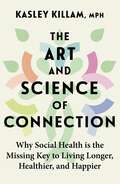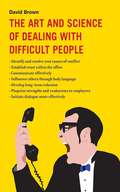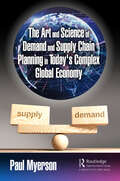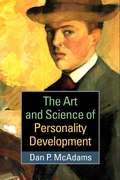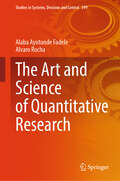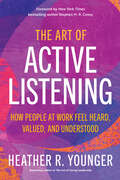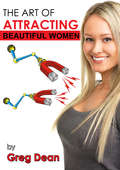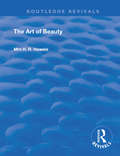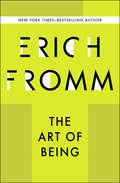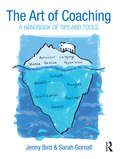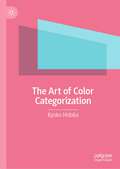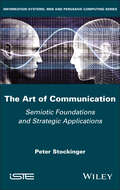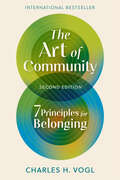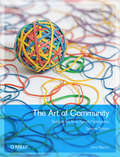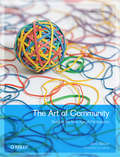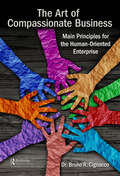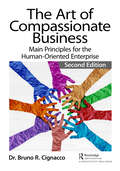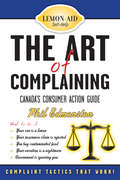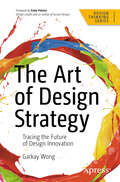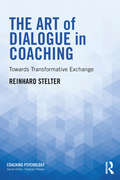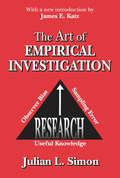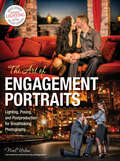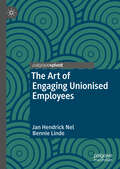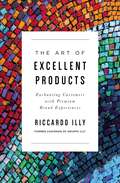- Table View
- List View
The Art and Science of Connection: Why Social Health is the Missing Key to Living Longer, Healthier, and Happier
by Kasley KillamA groundbreaking redefinition of what it means to be healthy that introduces the need for social health - the part of wellbeing that comes from feeling connected - to truly flourish.Exercise. Eat a balanced diet. Go to therapy. Most wellness advice is focused on achieving and maintaining good physical and mental health. But Harvard-trained social scientist and pioneering social health expert Kasley Killam reveals that this approach is missing a vital component: human connection.Relationships not only make us happier, but also are critical to our overall health and longevity. Research shows that people with a strong sense of belonging are 2.6 times more likely to report good or excellent health. Perhaps even more astonishingly, people who lack social support are up to 53% more likely to die from any cause. Yet social health has been overlooked and underappreciated - until now.Just as we exercise our physical muscles, we can strengthen our social muscles. Weaving together cutting-edge science, mindset shifts, and practical wisdom, Killam offers the first methodology for how to be socially healthy. An antidote to the loneliness epidemic and an inspiring manifesto for seeing wellbeing as not only physical and mental, but also social, The Art and Science of Connection is a handbook for thriving.In this essential book, you will:- Learn a simple yet powerful framework to understand, evaluate, and bolster your social health.- Discover the exact strategy or habit you need, as well as research-backed tips, to cultivate and sustain meaningful connection now and throughout your life.- Glean actionable insights to develop a sense of community in your neighbourhood, at work, and online from a spirited group of neighbours in Paris, the CEO of a major healthcare company, and an artificially intelligent chatbot.- Get an insider look at the innovative ways that doctors, teachers, entrepreneurs, architects, government leaders, and everyday people are catalysing a movement toward a more socially healthy society.The Art and Science of Connection will transform the way you think about each interaction with a friend, family member, coworker, or neighbour, and give you the tools you need to live a more connected and healthy life - whether you are an introvert or extrovert, if you feel stretched thin, and no matter your age or background. Along the way, Killam will reveal how a university student, a newlywed, a working professional, and a retired widow overcame challenges to thrive through connection-and how you can, too.
The Art and Science of Dealing with Difficult People
by David BrownIn The Art and Science of Dealing with Difficult People, David Brown pinpoints the seven principles of relationship building that are crucial to creating a successful working environment. Brown breaks down each principle by providing easy to understand instructions and universally applicable management skills.Brown's philosophy is to approach work place discord as a problem from both a managerial and lower level perspective. He offers advice on how to treat employees, while at the same time asking leaders to reflect and make self-adjustments which will facilitate a more efficient work space. Readers will gain a deeper understanding of how their employees view management personnel, what leadership skills are most effective, and how to ensure two-way communication. Using Brown's tried and true tools, anyone can learn to focus on how to motivate, establish trust, and form a psychological contract.Numerous case studies throughout allow readers to observe the concrete application of Brown's suggestions in real-life scenarios and complex situations, such as mergers and staff integration, information management, and more. In addition, The Art and Science of Dealing with Difficult People provides readers with skills drawn from an understanding of the basic fundamentals of human behavior.
The Art and Science of Demand and Supply Chain Planning in Today's Complex Global Economy
by Paul MyersonThe demand and supply chain planning process for manufacturers, distributors, and retailers has evolved over the years. It has gone from a disjointed, unconnected, slow, inaccurate, fairly manual set of processes to an integrated, timely process enabled by the use and coordination of highly trained people, lean, agile processes, and cutting-edge technology. To make this set of processes work effectively, one has to fully understand and appreciate that there is an "art and science" aspect to the process which can take years of education and experience to fully understand. Essentially, this book will offer the reader a chance to fully understand the interconnected set of processes in a "best-practice" application. Furthermore, examples and cases will be used to illustrate its practical application in today’s complex global supply chain. In addition, readers will understand and be able to apply and articulate the concepts, tools, and techniques used in the efficient supply of goods and services in today’s changing global economy. It will help them to learn how businesses, through their supply chain, work both internally and with their trading partners – both upstream and downstream – to build strong relationships and integrate demand and supply planning activities across the supply chain to deliver customer value efficiently and effectively. They will learn about the tools and technologies enabling integration, and the critical drivers and key metrics of supply chain performance.
The Art and Science of Personality Development
by Dan P. McadamsDrawing on state-of-the-art personality and developmental research, this book presents a new and broadly integrative theory of how people come to be who they are over the life course. Preeminent researcher Dan P. McAdams traces the development of three distinct layers of personality--the social actor who expresses emotional and behavioral traits, the motivated agent who pursues goals and values, and the autobiographical author who constructs a personal story for life. Highly readable and accessible to scholars and students at all levels, the book uses rich portraits of the lives of famous people to illustrate theoretical concepts and empirical findings.
The Art and Science of Quantitative Research (Studies in Systems, Decision and Control #599)
by Alvaro Rocha Alaba Ayotunde FadeleThis book reflects on the insights gained from exploring the key dimensions of quantitative research as outlined in the preceding chapters. Quantitative research, with its emphasis on objectivity, systematic methodologies, and statistical rigor, plays a pivotal role in advancing knowledge across diverse fields. The study began with an introduction to its foundational principles, highlighting its distinct characteristics and relevance. Key conclusions drawn from each chapter are summarized below:In the first chapter, a basic knowledge of quantitative research was presented, with an emphasis on the methodical and organized approach that quantitative research takes to the study of observable events. Quantitative research differs from qualitative research in that it focuses on numerical data, statistical analysis, and objective findings, as opposed to qualitative research, which investigates subjective experiences and meanings. This contrast highlights the crucial role that quantitative approaches play in hypothesis testing and predictive analysis, which makes them very beneficial for academic subjects that need empirical data and findings that can be replicated from experiment to experiment. In the next chapter, we delved further into the fundamental aspects of quantitative research, including its dependence on organized instruments (such as surveys and experiments), the significance of operationalizing variables, and the pursuit of results that can be generalized. When it comes to answering problems that need accuracy, scalability, and statistical validity, quantitative research is an indispensable tool because of these inherent characteristics. At the same time, the chapter brought attention to the attitude of the researcher, which includes taking an objective perspective, reducing prejudice, and adhering to ethical norms. This frame of mind is very necessary in order to guarantee the honesty and dependability of the findings of the investigation.
The Art of Active Listening: How People at Work Feel Heard, Valued, and Understood
by Heather YoungerImprove communication, engagement, and culture with active listening.When employees, colleagues, and customers are not being heard, organizational culture, employee happiness, and overall organizational success will suffer. How well do you listen?Active listening is the doorway to increased belonging, loyalty, profitability, innovation, and so much more. It is the difference between thinking we understand what people want and knowing what they want. Want to build stronger relationships, avoid misunderstandings, and anticipate problems before they surface at work? All you have to do is listen.The Art of Active Listening introduces a 5-step framework that shows you how to listen successfully and act upon what you are hearing. Readers will discover how to:1. Recognize the unsaid2. Seek to understand3. Decode4. Act 5. Close the loopBacked by her personal review of over 30,000 employee and customer surveys and facilitation of 100's of focus groups, Younger discovered one universal truth: We all want to be heard. We want our voices to matter. We want the work we do to matter. When we get this right - when we listen to our employees and customers and care about them not just for what they can do but for who they ARE - they can and will move mountains.Using the tools provided in this book, you can implement active listening, regardless of whether you're in-person or virtual, that benefits all team members and customers, strengthens overall engagement, improves organizational culture and creates a space for everyone to have a voice.When those at work feel heard, they will do whatever it takes to achieve outcomes that serve your relationship and your organization.
The Art of Attracting Beautiful Women
by Greg DeanA powerful dating advice bible for men. Are you sick of having little success with women and afraid you will continue to stay forever single? Are you low in confidence and cannot find a way out? The Art of Attracting Beautiful Women is a deep, philosophical and complete technical guide to meeting an amazing and stunning woman. Renowned date coach, Greg Dean explores his extraordinary dating tips and social dynamic theories in a way you have never read before. This is not only a step by step guide on how to attract and seduce women, it will give you the psychological mindset, realisations about your true worth and the confidence to attract women in abundance in a way you may have never explored before.
The Art of Beauty (Routledge Revivals)
by H. R. HaweisThis book was originaly published in 1878. The Culture of beauty is everywhere a legitimate art. But the beauty and adornment of the human form, the culture of personal beauty, is of the first interest and importance. This book explores the art of beauty, including chapters on the pleasure of beauty, the importance of dress, and the moralities of dress.
The Art of Being
by Erich FrommA guide to well-being from the renowned social psychologist and New York Times–bestselling author of The Art of Loving and Escape from Freedom. Though laptops, smartphones, and TVs have in many ways made life more convenient, they have also disconnected us from the real world. Days are spent going from screen to machine, machine to screen. In The Art of Being, renowned humanist philosopher and psychoanalyst Erich Fromm draws from sources as varied as Sigmund Freud, Buddha, and Karl Marx to find a new, centered path to self-knowledge and well-being. In order to truly live, Fromm argues, we must first understand our purpose, and the places where we lost it. This ebook features an illustrated biography of Erich Fromm including rare images and never-before-seen documents from the author&’s estate.
The Art of Change: Transforming Paradoxes into Breakthroughs
by Jeff DeGraff Staney DeGraffIn a world of unprecedented disruption, mastering the art of change isn't just an advantage—it's essential for survival. Drawing from decades of work with global organizations, military commanders, and NASA leaders, Jeff and Staney DeGraff reveal how true transformation emerges not from avoiding contradictions, but from embracing them. This groundbreaking book, the third installation in their comprehensive innovation series, introduces a revolutionary framework for understanding and leveraging paradox. Through rich storytelling and battle-tested strategies, the DeGraffs unpack seven fundamental contradictions that define transformative growth: How do we achieve more by doing less? Why does certainty often lead to failure, while embracing uncertainty paves the path to breakthrough? When does resistance become the catalyst for change? The Art of Change demonstrates how these seeming contradictions hold the key to profound transformation—both personally and professionally. This isn't just another business book—it's a practical philosophy for navigating complexity in dynamic environments. Whether you're leading a Fortune 500 company, steering a non-profit through turbulent times, or seeking personal growth, you'll discover: A proven framework for turning obstacles into opportunities Practical tools for making better decisions in ambiguous situations Strategies for building resilience through embracing paradox Methods for driving innovation by challenging conventional wisdom Techniques for leading transformational change in any environment The Art of Change completes a pioneering trilogy that establishes a comprehensive school of thought around innovation and transformation. Building on the foundations laid in their previous works, the DeGraffs provide their most sophisticated and nuanced exploration yet of how to drive meaningful change in complex systems. Don't just manage change—master it. Learn how to transform paradoxes into breakthroughs and turn uncertainty into your greatest advantage. The Art of Change is your essential guide to navigating the contradictions that define our era and achieving lasting transformation in an increasingly fluid world.
The Art of Coaching: A Handbook of Tips and Tools
by Sarah Gornall Jenny BirdThe Art of Coaching is a book to shift thinking and open up new possibilities, to stimulate fresh insight, to adapt to your needs as a coach or manager and to use creatively in practice. Written by two experienced, highly qualified international coaches and supervisors, this creative book offers ideas to use across the range of coaching contexts including leadership, decision making, change and supervision. Combining brand-new, original diagrams with classic models from the learning development and management fields, Jenny Bird and Sarah Gornall have a created a valuable resource for quick reference, instant accessibility and fast learning, built on a strong theoretical base. Each model in the book is explained with a clear, accessible diagram and a simple guide to what it is, how it works and how to put it into action. The text is full of inspiration for applications of the ideas in scenarios based on real coaching practice. The Art of Coaching will be an invaluable companion for coaches looking for new ways of developing awareness with clients, coaching students and trainees, coach supervisors, learning and development professionals and those working in human resource departments.
The Art of Color Categorization
by Kyoko HidakaFrom Newton's prism spectroscopy to modern color science, the study of color has been rooted in the categorization of colors. Building upon this foundation, this book aims to explore the rich and varied examples of color theory through two basic concepts: categorizing colors themselves and categorizing things by color. How have different cultures drawn the line between colors, and why? What do these divisions reveal about color naming, standards, environments, and sensory perceptions? The book delves into these questions, shedding light on how color categorization has shaped our world. Through this exploration of color theory, the author also hopes to draw attention to the potential parallels between Western color classifications and the logic of racism. By examining various theories on color classification standards, the author seeks to unravel this complex issue and encourage readers to reflect on how our understanding of color and categorization can impact our social and cultural attitudes.
The Art of Communication: Semiotic Foundations and Strategic Applications (ISTE Invoiced)
by Peter StockingerThe Art of Communication combines over two decades of research and teaching into a comprehensive guide on strategic communication. Grounded in the theoretical and methodological frameworks of 'situated communication' and 'communication project', this book highlights an understanding of both traditional and emerging communication practices. It particularly focuses on new genres, such as branding, design and digital communication strategies, and introduces the innovative concept of 'textscapes' – specially crafted environments to fulfill communicative objectives. This book is enriched with practical examples and is particularly relevant in multicultural and international settings, providing essential insights for adapting communication strategies to diverse cultural contexts.
The Art of Community, Second Edition: 7 Principles for Belonging
by Charles H. VoglSecond edition of this bestselling book on creating robust, thriving, positive communities using seven ancient principles any organization can follow.Now with 25% new content, including a chapter on building virtual communities.Healthy communities strive for their members to support one another, share their passions, and achieve personal growth. This book will help you learn to be connected and defeat loneliness by understanding where and how we belong. No matter the kind of organization, company, or social group, this book is a guide for leaders seeking to build a community or strengthen the ones they already have.Drawing on both 3,000 years of history and his personal experience, Charles Vogl lays out seven time-tested principles for developing connected communities that last. These include:•Boundary: The boundary between members and outsiders•Initiation: The activities that mark a new member•Rituals: The things we do that have meaning•Temple: A place set aside to find our community•Stories: What we share that allows others and ourselves to know our values•Symbols: The things that represent ideas that are important to us•Inner Rings: A path to growth as we participateWith hands-on tools for applying these principles to any group-formal or informal, mission driven or social, physical or virtual-this book will guide you in your journey to become a community builder that brings people together
The Art of Community: Building the New Age of Participation
by Jono BaconOnline communities provide a wide range of opportunities for supporting a cause, marketing a product or service, or building open source software. The Art of Community helps you recruit members, motivate them, and manage them as active participants. Author Jono Bacon offers experiences and observations from his 14-year effort to build and manage communities, including his current position as manager for Ubuntu.Discover how your community can become a reliable support network, a valuable source of new ideas, and a powerful marketing force. This expanded edition shows you how to keep community projects on track, make use of social media, and organize collaborative events. Interviews with 12 community management leaders, including Linus Torvalds, Tim O’Reilly, and Mike Shinoda, provide useful insights.Develop specific objectives and goals for building your communityBuild processes to help contributors perform tasks, work together, and share successesProvide tools and infrastructure that enable members to work quicklyCreate buzz around your community to get more people involvedHarness social media to broadcast information, collaborate, and get feedbackUse several techniques to track progress on community goalsIdentify and manage conflict, such as dealing with divisive personalities
The Art of Community: Building the New Age of Participation (Theory in Practice)
by Jono BaconOnline communities offer a wide range of opportunities today, whether you're supporting a cause, marketing a product or service, or developing open source software. The Art of Community will help you develop the broad range of talents you need to recruit members to your community, motivate and manage them, and help them become active participants. Author Jono Bacon offers a collection of experiences and observations from his decade-long involvement in building and managing communities, including his current position as manager for Ubuntu, arguably the largest community in open source software. You'll discover how a vibrant community can provide you with a reliable support network, a valuable source of new ideas, and a powerful marketing force.The Art of Community will help you:Develop a strategy, with specific objectives and goals, for building your communityBuild simple, non-bureaucratic processes to help your community perform tasks, work together, and share successesProvide tools and infrastructure that let contributors work quicklyCreate buzz around your community to get more people involvedTrack the community's work so it can be optimized and simplifiedExplore a capable, representative governance strategy for your communityIdentify and manage conflict, including dealing with divisive personalities
The Art of Compassionate Business: Main Principles for the Human-Oriented Enterprise
by Bruno R. CignaccoThere are several well-ingrained assumptions regarding the dynamics of work and business activities, which can be refuted. Some examples of these widespread assumptions in the business and work environments are: employees being viewed as commodities, competitors perceived as threats, companies’ resources seen as limited, and customers perceived as scarce and difficult, etc. All which leads to the question, "Is there a way to perform business activities more humanely?" This book challenges the reader to change the way they perform in business situations and become more focused on the human aspects of business activities. The users of this knowledge and those affected by them will undergo a profound transformation in the way they perform business activities. They will benefit from gradually testing and implementing the guidelines conveyed in this book, both in the business environment and the workplace. When readers put these principles into practice, positive ripple effects are bound to affect other stakeholders of the organization they work for or own. This book includes aspects related to mission and vision, passion, business mindset, organizational learning, improvement of business conversations, use of constructive criticism and improvement of relationships with the most relevant stakeholders (customers, suppliers, intermediaries, community, and employees, etc.). The book also includes a discussion of creativity and the innovation process, as well as other factors that create a healthy business environment. Extensive appendices include topics such as negotiation, marketing, use of social media and others.
The Art of Compassionate Business: Main Principles for the Human-Oriented Enterprise
by Bruno R. CignaccoThere are several well-ingrained assumptions regarding the dynamics of work and business activities, which can be refuted. Some examples of these widespread assumptions in business and work environments are employees being viewed as commodities, competitors perceived as threats, companies’ resources seen as limited, and customers perceived as scarce and difficult. All this leads to the question: "Is there a way to perform business activities more humanely?" The second edition of this book challenges the reader to change the way they perform in business situations and become more focused on the human aspects of business activities. The users of this knowledge and those affected by them will undergo a profound transformation in the way they perform business activities. They will benefit from gradually testing and implementing the guidelines conveyed in this book, both in the business environment and in the workplace. When readers put these principles into practice, positive ripple effects are bound to affect other stakeholders of the organisation they work for or own. The author has refreshed all the concepts and examples introduced in the first edition which include aspects related to mission and vision, passion, business mindset, organisational learning, improvement of business conversations, use of constructive criticism, and betterment of relationships with the most relevant stakeholders (customers, suppliers, intermediaries, community, employees, etc.). The author also includes a discussion of creativity and the innovation process as well as other relevant aspects related to a healthy business environment and provides various real-life examples of companies which have adopted a loving attitude towards their stakeholders – which has become so important in the current business environment.
The Art of Complaining: Canada's Consumer Action Guide
by Phil EdmonstonDefective cars, contaminated food, insurance company abuses, botched vacations, or government errors and indifference. The Art of Complaining evens the playing field. Most people hate to complain and so they will put up with defective cars, contaminated food, insurance company abuses, botched vacations, and government errors and indifference. The Art of Complaining evens the playing field.The Art of Complaining gives readers an arsenal of successful complaint tactics and claim letters compiled by Phil Edmonston, Canada’s best-known consumer advocate and the author of the best-selling Lemon-Aid car guides. The Art of Complaining takes readers on a 45-year journey of consumer advocacy seen through the eyes of this former Member of Parliament, Ralph Nader Associate, and former member of the boards of Consumer Reports and The Quebec Bar Association. Edmonston has battled carmakers, dealers, insurance companies, lawyers, and government officials, both in the courts and in the streets. Indeed, Phil is Canada’s toughest customer.
The Art of Design Strategy: Tracing the Future of Design Innovation (Design Thinking)
by Garkay WongAlthough business leaders and designers may appear to have different objectives, they actually share a common goal: ensuring the long-term success and profitability of their organization. This book highlights the shared objective, examining the progression of Design Strategy to bridge the gap between design practice and executive decision-making. Featuring the TRACES framework, it aligns design initiatives with overarching business goals, enhancing design-led strategies. The topic is a timely one. A recent article published by FastCompany has touched a nerve among design leaders, highlighting the urgent challenges and anxieties they face about the future of design. It’s sparked a conversation on the need for a new direction within the industry. As we stand on the precipice of the next design shift and design leaders ponder their next steps, The Art of Design Strategy offers a much-needed perspective, providing insights on how to elevate design to a strategic level and secure its place at the heart of business innovation. What You’ll Learn Understand the key principles of design strategy and management. Build a design-led work culture within your organization. Examine the TRACES framework to align design initiatives with your business goals. Gain deeper insights of the future landscape of the design industry. Who This book Is For Designers who are interested in design management and its implications, transitioning from design craft to management roles, and managers and design leaders who are looking to understand the strategic value of design in various business areas.
The Art of Dialogue in Coaching: Towards Transformative Exchange (Coaching Psychology)
by Reinhard StelterIn The Art of Dialogue in Coaching, Reinhard Stelter invites readers to engage in transformative and fruitful dialogues in everyday working life, and provides the theory and tools for them to be able to do so. Presented in three parts, the book provides a complete overview of the importance of dialogue and how it can be utilised. Part I, Theoretical basis, examines third-generation coaching as a collaborative dialogue form, the societal context of the coaching process and the concept of identity in modern society. Part II, Basic themes of fruitful dialogue, examines meaning-making, value and the narrative perspective, and their significance in creating a new dialogue culture. Finally, Part III, Reflections on dialogue practice, explores the art of being a supporting dialogue guide, drawing on a number of theoretical perspectives and focusing on developing relational competencies. Stelter emphasises that taking the time to linger opens new possibilities for fundamental self-insight, and clearly explains how dialogue provides us with a framework for acting in the world with personal integrity. The Art of Dialogue in Coaching will be an essential guide for coaches in practice and in training, coaching psychologists and professionals with a coaching role, including mentors, consultants and leaders. In particular, it will appeal to those looking to conduct dialogue as an art form, enhancing their work as a co-creative and collaborative guide.
The Art of Empirical Investigation
by James E. Katz Julian L. SimonJulian Simon was known for his methodical, and often controversial, writings challenging conventional beliefs about overpopulation, pollution, disappearing farmland, and the scarcity of energy sources and raw materials. But throughout his works is a common theme: that responsible, unbiased research and examination of the data is indispensable to formulating a well-informed and accurate opinion. The Art of Empirical Investigation teaches student, professor, researcher, and those interested in ascertaining the truth about social issues just how to proceed.The Art of Empirical Investigation is a textbook on the basics of social-scientific research. It discusses all the important empirical methods used in social science, and its examples, drawn from a wide variety of academic and applied fields, illustrate the use of each method in its most appropriate context. The actual decisions a researcher must make at every stage of a project are emphasized, as well as obstacles to knowledge--such as observer bias, deception, unreliability of data, and sampling costs--and how to overcome them. Presupposing nothing, the book introduces the reader to the foundations of empirical social-science research, regardless of a specific field. It also makes an important contribution to beginning researchers' understanding of an operational definition of causality, which cuts through philosophical obscurity and teaches the researcher how to decide whether or not a given relationship is causal.
The Art of Engagement Portraits
by Neal UrbanWith bold colors, inventive lighting, creative postproduction, and eye-catching poses, Neal Urban creates engagement portraits that go far beyond the expected. In this book, he takes you behind the scenes with dozens of couples to show you how each image was conceptualized, customized, and brought to life. Under Neal’s careful eye, a patch of tall grass in a parking-lot becomes an exotic setting for two, the couple’s favorite dive-bar is transformed into a backdrop for timeless romance, and city streets become cinematic wonders. Shooting in the late-afternoon, sunset, and evening hours, Urban works carefully with the natural light, ambient sources in the scene, off-camera flash, LED, and tungsten sources to beautifully sculpt the couple and bring his scenes to life. Spend a few hours perusing this book and you’ll never approach engagement photography the same way again!
The Art of Engaging Unionised Employees
by Bennie Linde Jan Hendrick NelThis book introduces a framework to assist human resource practitioners and organisations embrace strategies that will drive high engagement levels within organisations with a union presence. The authors address established definitions of engagement and how they have been conceptualised in academic and practitioners’ literature, before exploring and unpacking circumstances that influence levels of engagement amongst employees in a unionised environment. In doing so, the framework introduced elaborates on approaches and interventions with the greatest potential to create, improve, and embed high levels of engagement within the unionised work environment.
The Art of Excellent Products: Enchanting Customers with Premium Brand Experiences
by Riccardo IllyItalian brands are known to create some of the most premium, sought-after products in the world. Learn to compete in the modern marketplace using the proven business principles that Italian brands have been employing for generations. While it is no secret that Italians create superior products that both withstand the threat of ongoing competition and stand the test of time, the specific business principles that have led to such tried and tested successes are shrouded in secrecy … until now.Through the age of intense competition from Starbucks and Coffee Bean, the Illy empire has remained at the top of the coffee industry simply by employing key Italian business principles and values. Steeped in businessman Riccardo Illy&’s personal experiences using these tried and tested Italian business standards to run his family&’s world-renowned coffee company for generations you will: Learn how to approach your research and development process to find ways to add quality to your products and brand. Understand how Italians have created so many brands that have stood the test of time. Learn how to approach the marketplace so that your product stands out as the go-to product. By applying those principles to your business, you will ensure your products meet or exceed the level of quality necessary to be ultra-competitive in today&’s market, even in an industry in which new companies aggressively challenge your brand daily.
